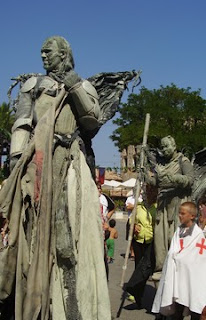Not so long ago this sort of thing would have been unheard of and near impossible - due to the distance, travel time, costs and dangers . Now, with local airports and budget airlines , travel is much more accessible and safe -at least for people in the West.
Its hard to imagine that people are still undertaking dangerous journeys across the sea in flimsy boats with a real risk of death-and spending all their life savings to do so.
This is a cayuco, a Senagalese fishing boat. They are normally used for fishing rivers and estuaries and not intended for sea crossings.
Basically they are a form of large canoe and this one was in a terrible state -and probably not exactly sea worthy at the start of the journey, never mind the end.
 I've quickly removed the stone jetty from behind the cayuco to show the shape and size of the boat.
I've quickly removed the stone jetty from behind the cayuco to show the shape and size of the boat.
Tenerife is fairly close to North Africa and in recent years there has been an upsurge in the number of illegal immigrants trying enter European territory in the hope of making a new life.
Unfortunately, many people die in the attempt or end up exploited in a kind of indentured service to pay the huge amounts of money for the passage.
The cayucos are jampacked with people when they set out on the 8 to 10 day crossing and its not known how many cayucos sink on the journey. I have heard estimates that over a thousand people have died in the attempt to reach the Canary Islands since the 2006
90 men were rescued from this boat when it was intercepted. 6 people were in critical condition and sadly one man died later in hospital, probably from the effects of exposure and dehydration.
The coastguard emergency boat that intercepted the cayuco is in the foreground and the cayuco is visible behind.

When we arrived at the port to take photos we saw the bright orange emergency boats and initially thought there had been a training exercise rather than a real emergency.
It was only when we saw the rickety cayuco and the ambulances and men being lead off for medical treatment that we realized what had happened.
The Spanish red cross and medical teams were giving medical aid, food, water and clothes to the people from the cayuco inside these inflatable tents.
 After medical treatment, the men are repatriated if their nationality can be established.
After medical treatment, the men are repatriated if their nationality can be established.The cayucos are destroyed since unsafe fuel storage generally leads to the hull being impregnated with fuel. Plus so many people crammed onto a tiny boat leads to unsanitary conditions and the boats are considered hazardous to health.
Technorati Tags: cayuco, photos, tenerife, red cross















